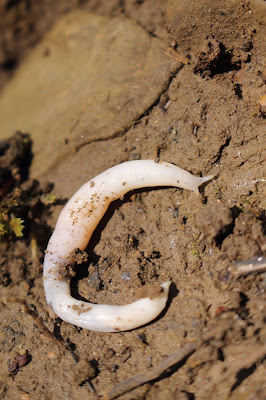Just a ten minute walk away is Company's Wood. This ancient woodland sits between the larger Lasgarn Wood to the north and Freeholdland Wood to the south. Combined, the three woodlands form a continuous wooded corridor that stretches for more than a mile through Torfaen's upper Eastern Valley.
From a road bridge over the Afon Lwyd a footpath snakes steeply through the tree canopy complete with its underlying geology of carboniferous limestone. A ghost slug stopped me in my tracks. This milky white mollusc is unmistakable. Interestingly I've recorded this recent coloniser previously on the outskirts of Pontypool Park, here too close to the Afon Lwyd. Onward through the woodland, passing a flowering cherry tree and a number of path side field maple, birdsong was pronounced. Nuthatch, chiffchaff, willow warbler and blackcap were all in fine voice.
At the top of the climb the path emerged onto what we knew as youngsters, as the tramline. This is a remnant of industrial activity from bygone days. A track that was used to move limestone across the valley to sites such a The British ironworks. I paused to catch my breath - much needed for one that is approaching sixty one. Around this intersection I could find bluebell just coming into flower along with ramsons, yellow arcangel and pitnut. A few people passed, including a couple who asked me about butterflies.
From the intersection I took the tramline route north for a while before turning east. This took me into an area of larch clear fell. A tree pipit sang from a tall spindly silver birch before parachuting in full song to a tree with more cover. A lad of a scrambler bike passed heading north. My time was up so I made my way back whence I came. On the way I, paused again, as naturalist often do, to photograph the distinctive leaf mine of the fly Chromatomia scolopendri on harts tongue fern.
From a road bridge over the Afon Lwyd a footpath snakes steeply through the tree canopy complete with its underlying geology of carboniferous limestone. A ghost slug stopped me in my tracks. This milky white mollusc is unmistakable. Interestingly I've recorded this recent coloniser previously on the outskirts of Pontypool Park, here too close to the Afon Lwyd. Onward through the woodland, passing a flowering cherry tree and a number of path side field maple, birdsong was pronounced. Nuthatch, chiffchaff, willow warbler and blackcap were all in fine voice.
At the top of the climb the path emerged onto what we knew as youngsters, as the tramline. This is a remnant of industrial activity from bygone days. A track that was used to move limestone across the valley to sites such a The British ironworks. I paused to catch my breath - much needed for one that is approaching sixty one. Around this intersection I could find bluebell just coming into flower along with ramsons, yellow arcangel and pitnut. A few people passed, including a couple who asked me about butterflies.
From the intersection I took the tramline route north for a while before turning east. This took me into an area of larch clear fell. A tree pipit sang from a tall spindly silver birch before parachuting in full song to a tree with more cover. A lad of a scrambler bike passed heading north. My time was up so I made my way back whence I came. On the way I, paused again, as naturalist often do, to photograph the distinctive leaf mine of the fly Chromatomia scolopendri on harts tongue fern.
 |
| Ghost slug |
 |
| Ramsons |
 |
| Leaf mine of Chromatomia scolopendri |

No comments:
Post a Comment